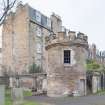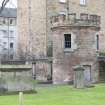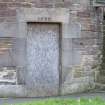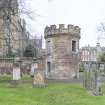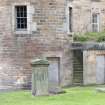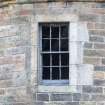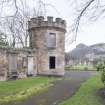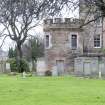Edinburgh, 31 East Preston Street, Newington Old Burial Ground, Watch Tower
Watch Tower (19th Century)
Site Name Edinburgh, 31 East Preston Street, Newington Old Burial Ground, Watch Tower
Classification Watch Tower (19th Century)
Alternative Name(s) Dalkeith Road
Canmore ID 275066
Site Number NT27SE 2626.01
NGR NT 26635 72391
Datum OSGB36 - NGR
Permalink http://canmore.org.uk/site/275066
- Council Edinburgh, City Of
- Parish Edinburgh (Edinburgh, City Of)
- Former Region Lothian
- Former District City Of Edinburgh
- Former County Midlothian
NT27SE 2626.01 26635 72391
INVENTORY OF GRAVEYARD AND CEMETERY SITES IN SCOTLAND REFERENCE:
N.B. This reference applies collectively to NT27SE 2626.00 and NT27SE 2626.01
Address: Newington Old Burial Ground and Watch Tower, East Preston Street, Edinburgh
Postcode: EH16 5BS
Status: Closed for burials but maintained
Size: 0.91 hectares, 2.25 acres
Polygon: No
TOIDs:
Number of gravestones: Not known
Earliest gravestone: Not known
Most recent gravestone: Not Known
Description: Early municipal burial ground opened 4 December 1820, with watch tower and iron railing mortsafe enclosure.
Data Sources: OS MasterMap checked 15 September 2005; Bereavement Services Portal checked 15 September 2005
Newington Old Burial Ground Watchtower was recorded as part of the Threatened Buildings Survey. The burial ground was opened on 4th December 1820 as an extension to the Buccleuch Burial Ground. The watch tower was a necessary precaution against the resurrectionists or body snatchers who were active at this time. The watchtower is very similar, if one storey shorter, to the one of a similar date at the Calton New Burial Ground, Regent Road, Edinburgh.
2-stage, circular-plan, corbelled and castellated watchtower with external staircase set in re-entrant angle of boundary walls; doorway at ground; 2 single windows and further doorway at 1st floor.
Opened on 4 December 1820 as an extension to Buccleuch burial ground which had become overcrowded. The high walls and watchtower (which housed an armed guard) were considered essential precautions against the resurrectionists. Notable internments; many leading Edinburgh clergymen and professionals along with Jean Lorimer ('Chloris'), subject of several of Burns' songs. (Historic Environment Scotland List Entry)















